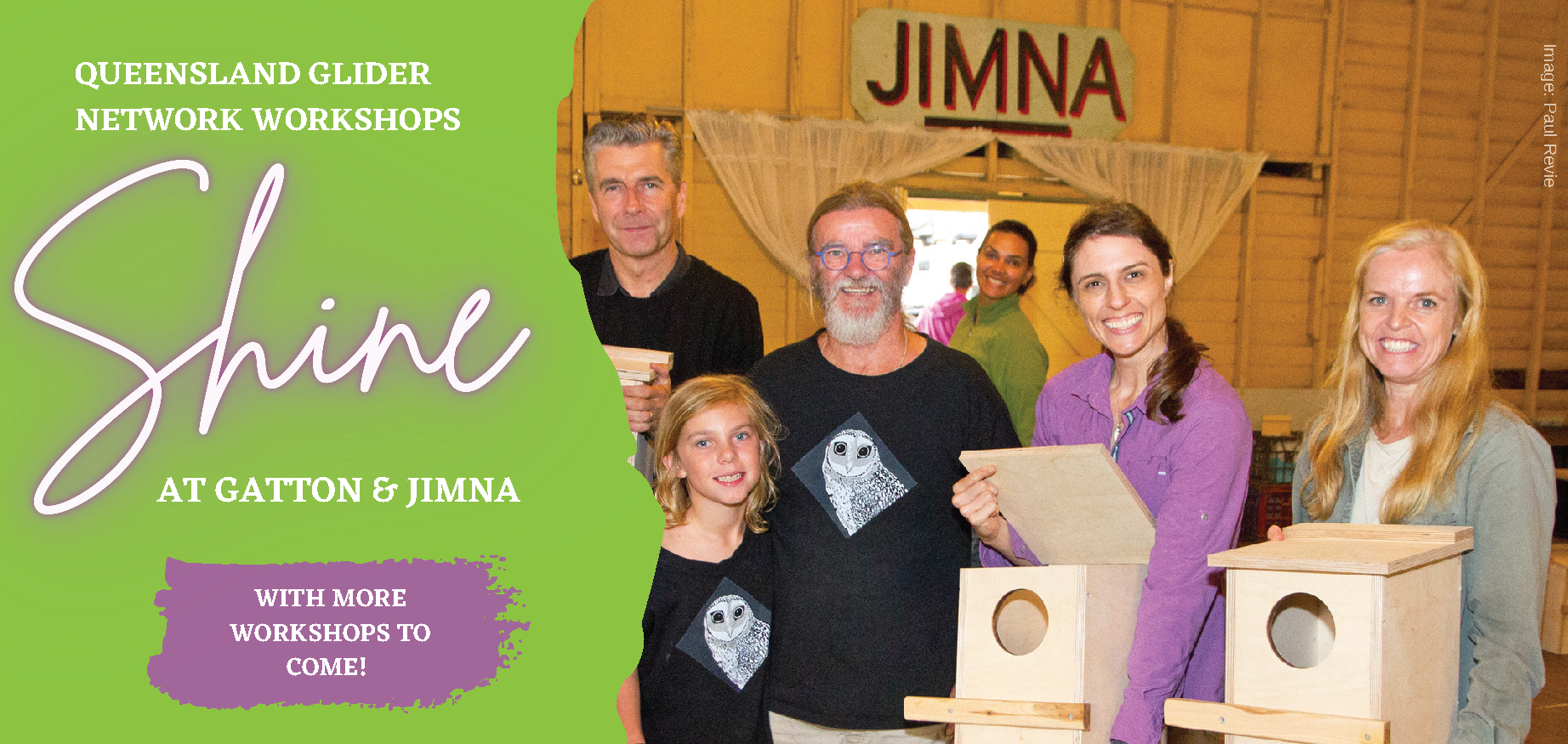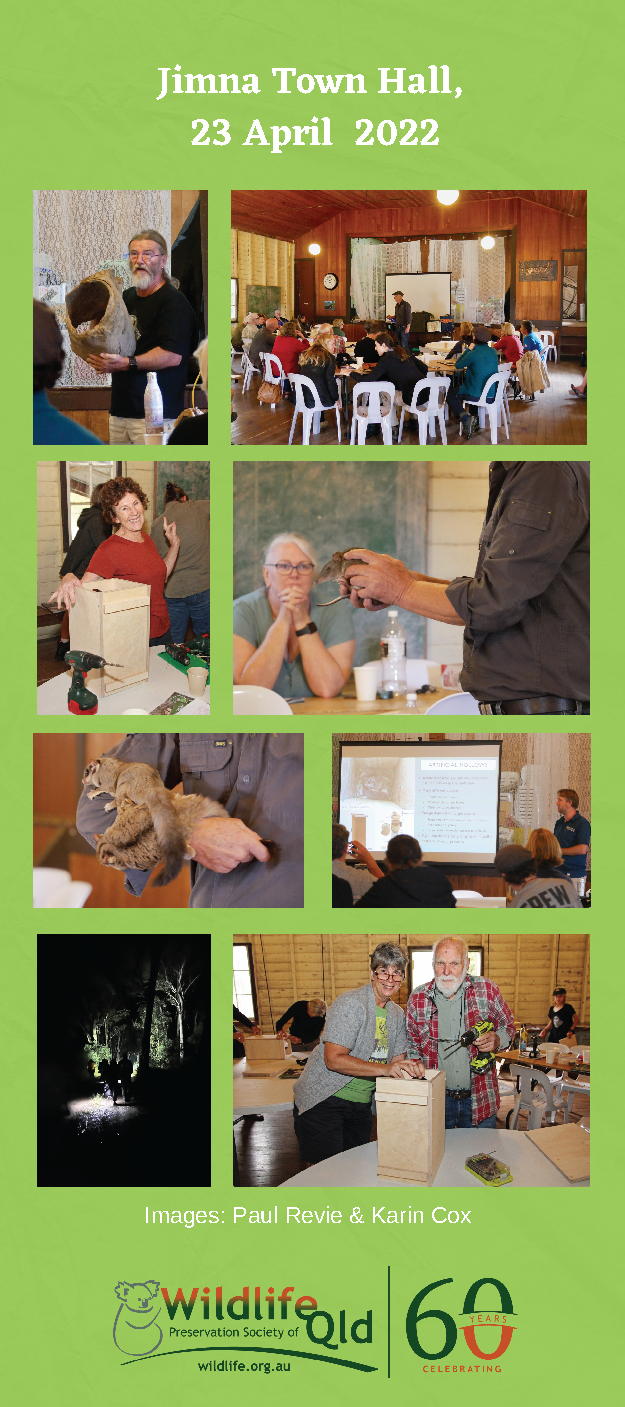
4 May 2022
Wildlife Queensland’s Queensland Glider Network (QGN) is rolling out a series of free half-day workshops to encourage landholders to help conserve threatened greater gliders and yellow-bellied gliders … and they’re so popular they’re attracting ‘glider groupies’.
Nest-box building, wildlife presentations, the chance to thrill to the aerial antics of gliders, and even a handy revegetation guide to take home to help you tailor plantings and attract gliders … what more could nature-loving landholders want in a workshop?
‘There are simple ways people, and particularly farmers and property owners, can alleviate some of the impacts the 2019–2020 bushfires have had on the endangered greater glider (Petaurus volans) and vulnerable yellow-bellied glider (Petaurus australis) in fire-affected regions,’ says Paul Revie, QGN’s Project Officer. ‘And that’s the good news we are trying to spread far and wide.’
Shining and dining
 Two workshops have been held so far. The first, on 2 April at the University of Queensland Gatton, was hosted in conjunction with Healthy Land and Water, International Fund for Animal Welfare, The Great Eastern Ranges, and Lockyer Uplands Catchment Inc. The second was hosted by Wildlife Queensland at historic Jimna Town Hall in the Somerset region on 23 April. Combined, the two drew close to 100 people of all ages and occupations. A slew of engaging activities was on offer, including:
Two workshops have been held so far. The first, on 2 April at the University of Queensland Gatton, was hosted in conjunction with Healthy Land and Water, International Fund for Animal Welfare, The Great Eastern Ranges, and Lockyer Uplands Catchment Inc. The second was hosted by Wildlife Queensland at historic Jimna Town Hall in the Somerset region on 23 April. Combined, the two drew close to 100 people of all ages and occupations. A slew of engaging activities was on offer, including:
- comprehensive presentations by Paul Revie (Wildlife Queensland’s Project Officer for the Queensland Glider Network) and Jessica Lovegrove-Walsh (from Friends of Nerang National Park) explaining the many perils these large gliding marsupials face and how private property owners can help save these species
- a nest-box building workshop with Alan Franks of Safe & Co and Hollow Log Homes, helping attendees build their very own nest box and teaching them how to install it using their trademarked Habisure installation method
- a fantastic Geckoes Wildlife presentation featuring animals from Martin Fingland’s menagerie, from stick insects to glossy black-cockatoos, barking owls, bandicoots, ‘Grumbles’ the gorgeous rufous bettong, and, of course, the stars of the show – ‘Astra’ and ‘Zeneca’ the squirrel and sugar gliders
- saving the best for last, there was also the chance to go spotlighting for wild gliders in the surrounding vegetation and reserves, and both groups saw plenty of other nightlife too.
Sadly, both of these larger glider species are now in real trouble, and both are also extremely hollow-dependent. Large, intense fires, which are predicted to worsen with climate change, are catastrophic for these gliders. Such blazes not only claim the lives of greater gliders and reduce some of the genetic diversity in what are already very isolated populations but also destroy the hollows these gliders desperately need for shelter and den sites – hollows that probably took 200 years or so to form.
Shelter is a fundamental need for all species, but a large glider that is forced ‘out on the street’ into patches of unsuitable habitat is very susceptible to attacks from marauding dogs and cats or to vehicle strikes and getting accidentally strung up on barbed wire.
‘We need to revegetate quickly, but the trouble is, hollows don’t form quickly – it can take centuries for a gum tree to hollow out,’ says Revie. ‘Deforestation has created a looming housing crisis for many hollow-dependent species.’
This bottleneck in hollow availability is why Alan and Stacey Franks, from Hollow Log Homes and Safe & Co. play such an important role, and why their inclusion in the workshops is so illuminating. Their range of solid, tried-and-tested glider nest boxes includes rear-entry boxes specifically designed to suit the needs of larger gliders. New, moulded boxes that replicate the thermal effects of a real hollow are also starting to show promise as artificial alternatives.
‘Everyone at the workshop loves the nest-box building element,’ insists Paul. ‘It’s so much fun to get on the tools and put one together while learning all about the native animals that might come and coexist in your backyard or on your property. It’s a great follow-on from the Geckoes Wildlife Presentation, where they get to personally encounter some of the species that need hollows and boxes.’
Monitoring of the next boxes also provides useful citizen science data. To complement the larger revegetation guide, Queensland Glider Network has also produced two smaller downloadable flipbooks on how to go about building a nest box and also how to monitor it by spotlighting to see which species are using it down the track.
I spy … eyes in the night sky!
‘Unfortunately, the two evening spotlighting events we have run haven’t yet turned up any greater or yellow-bellied gliders,’ says Josh Bowell of the Yellow-Bellied Glider Project, who hosted the spotlighting at Jimna. ‘Excitingly, we did find some notched food trees, which indicate the presence of yellow-bellied gliders. Now that we know there are glider feed trees, we can add this spot to our mapping records to try again another time.’

The Jimna groups did see a sugar glider (which volplaned overhead), a wild rufous bettong, two koalas, and several common brushtail possums, as well as hearing a barking owl in the vicinity after call playback. At the earlier Gatton event, spotlighting participants spied several sugar gliders being frenetically active under the red-light display and putting on an excellent gliding display.
‘We can’t wait to see what we encounter for our next two workshops, with one at Crows Nest on Mother’s Day, Sunday 8 May, and another at Camp Moogerah in the Scenic Rim on Saturday 28 May,’ adds Paul. ‘Ideally, we’d love to encounter greater gliders or yellow-bellied gliders in action, but it’s becoming harder and harder to find them. With the help of local landholders, we hope to arrest that decline and even recover populations in areas where we’ve improved connectivity, revegetated corridors and increased nest box availability near national parks and reserves and on farms and private properties.’
Other ways of knowing – and growing
Wildlife Queensland has also been liaising with Indigenous Traditional Owners for their input and advice.
‘We’re thrilled that the upcoming Mother’s Day event at Crows Nest will feature a Welcome to Country by Adrian Bauwens and a cultural dance display from the Nunukal Yuggera Dance Group, and we’re also really keen to pull together communities and hopefully share knowledge and information about traditional firestick burning and mosaic fire regime methods that might reduce the risk of devastating big blazes like the 2019–2020 bushfires,’ Revie says.
Overall, Queensland Glider Network hopes the workshops, along with the freely downloadable A Revegetation Guide to the Threatened Gliders of Southern Queensland and the chance to see these gliders going about their nocturnal business – and even magically whooshing overhead – will encourage people from all communities to get active in glider conservation and habitat regeneration. And it appears to be working … some attendees have enthusiastically brought friends along to more than one event.
In the Queensland Glider Network’s quest to save the state’s two largest gliding marsupials, it seems Wildlife Queensland’s newest glider guru is attracting ‘glider groupies’, and what (apart from possibly a greater glider) could be as warm and fuzzy at that?
Book online today for the Crows Nest Event.
Book online today for the Moogerah Event on the Scenic Rim.
View A Revegetation Guide to the Threatened Gliders of Southern Queensland as a flipbook below and download it by clicking on the PRINT button and printing to PDF.
Queensland Glider Network’s series of workshops and the revegetation guide for landholders were supported by the Australian Government’s Bushfire Recovery Program for Wildlife and their Habitat.
